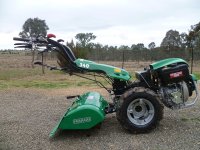I am guessing this is your tractor you have since this is your posted picture

now how will a loader work on this,
how will one support the load, say you have a bucket on it and scoop up some dirt, say one cubic foot, and that would weigh about 100 pounds, and if that is two feet in front of the wheels it will take 100 extra pounds two feet behind the wheels to keep it balanced,
so to load a wheel barrow that is 5 cubic foot it would take 5 to 6 loads, and if it was a larger than one cubic foot bucket I could not hold the back of it down, unless one extended the handles out there a good number of feet to increases the leverage of the handles to handle the weight,
am I not thinking this through correctly,
how high do you plan on the bucket lifting?
~~~~~~~~~~~~~~~~~~~~~~~~~
going back to the electric idea, have you considered a small electric winch, to lift with? and a trip on the bucket to dump.
back before hydraulics there were loaders that lifted with cables and winches, even crawler tractors used cable lift systems, and now there is small electric winches that could be used and there reasonable in cost,
https://www.google.com/search?num=1...j2.2.0....0...1c.1.37.serp..2.0.0.zEosAlpIqg0
I see some for as low as $70 on the page I posted,
page on old cable loaders
http://www.earthmover.com.au/news/2013/may/may-30/the-malcolm-moore-cable-loader-friends
~~~~~~~~~~~~~~~~~~~~~~~~~
loader on full sized tractors can become dangerously light on the rear end of the tractor, if one has a heavy load on the front,
~~~~~~~~~~~~~~~~~~~~~~~~~~
and if you have a pto making a mount to put a pump on it would be the simplest, and cheaper,
simple hydraulic system pump, tank, valve and cylinder, hoses,
you have a tank that holds oil, and a hose runs to the pump tank above pump best, pump moves the oil to the valve, and then a return line to the tank
when no working the oil (open center system), the oil just goes around and around in circles from tank to valve and then back to tank,
OK when you move the valve, oil is sent to a cylinder, and the oil pushes the piston in the cylinder,
If double acting there are two lines and oil is pushed out of the unpressured side back to tank via the valve and when the valve is in the opposite direction the other side of the cylinder is pressured,
on a single acting cylinder one hose and oil pushes the rod and vale holds it in place, reverse the vale it let it dump back to the tank (tank needs enough oil to fill cylinder full with out running out).

